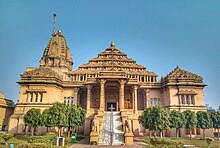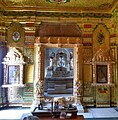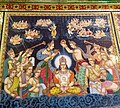Beawar is a city in Ajmer district of Rajasthan, India. Beawar was the financial capital of Merwara state of Rajputana. As of 2011, the population of Beawar is 342,935. It is located 70 kilometres from Ajmer, the district headquarters and 184 kilometres (114 mi) southwest of the state capital Jaipur, amidst Aravali hills. The city used to be a major center for trade, especially in raw cotton, and used to have cotton presses and the Krishna cotton mills. Currently, major industries include mineral-based units, machine-based units, machine tools and accessories, pre-stressed concrete pipes, plastic products, textiles, wooden furniture and asbestos cement pipes. Beawar is the largest producer of cement in northern India and home to Shree Cement. It is situated in a mineral-rich region having reserves of feldspar, quartz, asbestos, soapstone, magnesite, calcite, limestone, mica, emerald, granite, and masonry stone. Reserves of barytes, fluorite, wollastonite and vermiculite have also been found. Nearest airports are Jodhpur (145 km), Kishangarh and Jaipur (190 km). It is also connected by RSRTC operated buses to all parts of Rajasthan, and neighboring Delhi NCR, Ahmedabad (Gujarat), Gwalior. It also has railway connectivity with Delhi, Mumbai, Ahmadabad, Bangalore (bi-weekly), Haridwar, Dehradun (weekly), Bareilly and Muzzafarpur.

Delhi is an ancient centre of Jainism, home to over 165 Jain temples. Delhi has a large population of Jains spread all over the city. It has had continued presence of a Jain community throughout its history, and it is still a major Jain centre.
Virachand Raghavji Gandhi was a Jain scholar who represented Jainism at the first World Parliament of Religions in 1893. A barrister by profession, he worked to defend the rights of Jains, and wrote and lectured extensively on Jainism, other religions, and philosophy.

Shri Digambar Jain Lal Mandir is the oldest and best-known Jain temple in Delhi, India. It is directly across from the Red Fort in the historical Chandni Chowk area.

Jainism has been present in Maharashtra since ancient times. The famous Ellora Caves demonstrate that Jainism was part of a thriving religious culture in Maharashtra in premodern times.
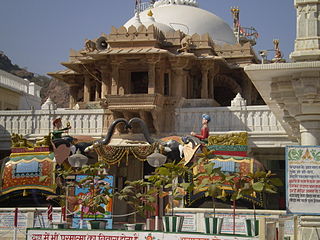
Nakoda Mewanagar is a village in the Barmer District of Indian state of Rajasthan. The village name is Mewanagar in the Rajasthan state Government records.

Sthānakavāsī is a sect of Śvētāmbara Jainism. It believes that idol worship is not essential in the path of soul purification and attainment of Nirvana/Moksha. Sthānakavāsī accept thirty-two of the Jain Agamas, the Svetambara canon.
Jahaj Mandir is a Jain temple in the village of Mandwala in the Jalore district, Rajasthan, India. The temple is built in the shape of a boat and is carved from marble. The temple was founded in 1993 for the religion of Jainism.
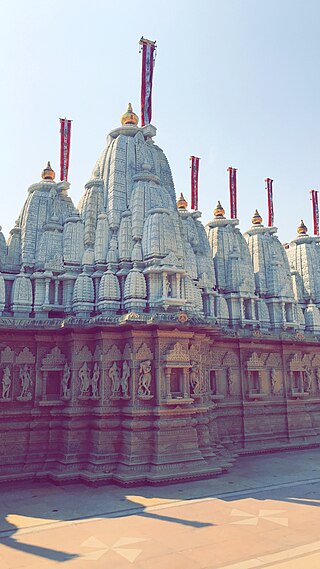
Shankheshwar is a town in the Patan district of Gujarat state of India. It is an important place of pilgrimage for the followers of Jainism.
Tapa Gaccha is the largest Gaccha of Svetambara Jainism.
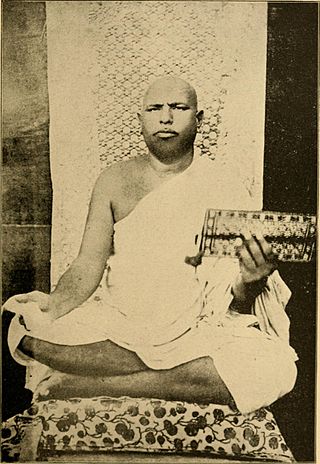
Acharya Vijayanand Suri, also known as Atmaramji of Gujranwala, was the first Swetambar Murtipujaka Jain monk in modern times to receive the title of Acharya. Born and raised in Punjab, he was initiated as a Sthanakvasi monk and later joined the Murtipujaka tradition. He travelled extensively in Gujarat, Rajputana and Punjab; he organised and reformed Jain community, ascetic orders and literature. He wrote several books in Hindi and was invited to the first World Parliament of Religions in 1893 which was attended by Virchand Gandhi later.

Acharya Vijay Vallabhsuri was a Jain monk. He was a disciple of Vijayanandsuri. He worked in Punjab so he was given honorific Punjab Kesari.
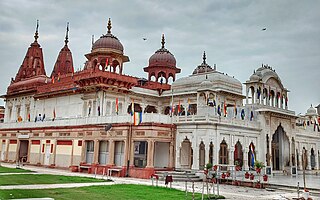
Shri Mahavir Ji is an important and prominent Jain pilgrimage site situated in Shri Mahaveerji town in Hindaun Block, Karauli district in Rajasthan. Given the importance of the religious place, the Indian Railways has specifically developed a railway station under West Central Railway zone by the name of Shri Mahaveerji railway station which is 10 minutes drive from the temple and temple authorities have arranged for regular buses from the station to the temple. The temple is visited by millions of Jain and Hindu devotees every year.
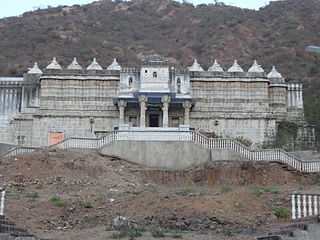
Mirpur Jain Temple is situated in Mirpur, a fortified village in the Sirohi district of Rajasthan, India. The village has four Jain temples.

The Statue of Vasupujya located at Champapur in the Indian state of Bihar, is one of the tallest statues in eastern India and the tallest statue of Lord Vasupujya in India. The statue is dedicated to Vasupujya, the twelfth Jain Tirthankara of the present cosmic age. The height of the statue is 31 ft. The statue was constructed and donated by Smt Sona Devi Sethi Charitable trust, Nagaland. Champapur is a Siddhakshetra and occupies a very significant place among the Jains. This is said to be the place where all the five kalyanaks - Garbh, Janam, Diksha, Kevalgyana and Moksh kalyanak of Tirthankara Vasupujya took place. It is said that the first tirthankar Rishabha, twenty-third Tirthankara Parshvanath and last tirthankara Mahavira had their Chaturmas at this place. Mahavira had his third and twelfth Chaturmas at this place.
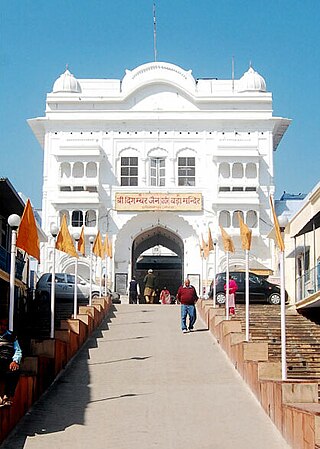
Shri Digamber Jain Prachin Bada Mandir is a Jain temple complex located in Hastinapur, Uttar Pradesh. It is the oldest Jain temple in Hastinapur dedicated to Shri Shantinatha, the 16th Jain Tirthankara.
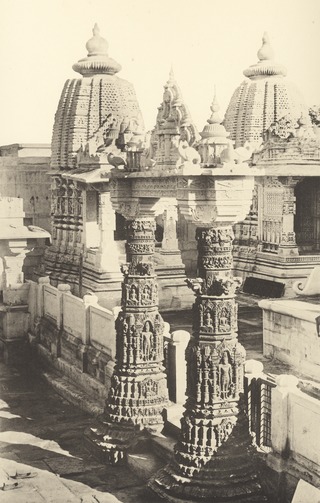
The Mahavira Jain temple is built in Osian of Jodhpur District, Rajasthan. The temple is an important pilgrimage of the Oswal Jain community. This temple is the oldest surviving Jain temple in Western India and was built during the reign of Mahārāja Śrī Vatsarāja of Imperial Pratihāras. The temple is visited by both Jain and Hindu.
